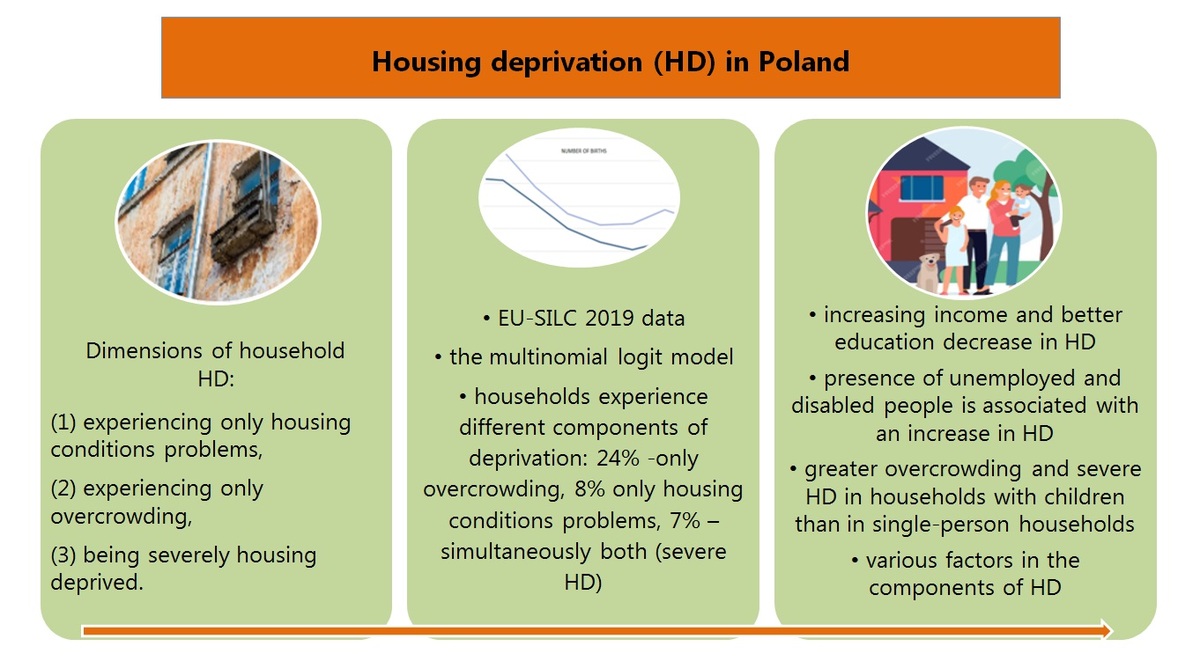Current issue
Online first
Archive
About the Journal
Aims and scope
Editorial Board
International Editorial Board
List of Reviewers
Abstracting and indexing
Ethical standards and procedures
REMV in Social Media
Contact
Instructions for Authors
Instructions for Authors
Manuscript formatting template
Title page
Highlights
Payments
‘Ghostwriting’ and ‘Guestauthorship’
Guidelines for Referees
Housing deprivation among Polish households: Prevalence and associated factors
1
Institute of Economics and Finance, Warsaw University of Life Sciences, Poland
Submission date: 2023-10-02
Final revision date: 2023-12-12
Acceptance date: 2023-12-29
Corresponding author
Agnieszka Wojewódzka- Wiewiórska
Institute of Economics and Finance, Warsaw University of Life Sciences, Poland
Institute of Economics and Finance, Warsaw University of Life Sciences, Poland
REMV; 2024;32(2):58-69
HIGHLIGHTS
- severe housing deprivation includes components – overcrowding and housing problems
- we investigate the prevalence of three-dimensional housing deprivation
- we focus on socioeconomic features of the household that are associated with housing deprivation
- we use a multinomial logit model to measure risk of housing deprivation
- increasing income and better education cause a decrease in housing deprivation in households
KEYWORDS
TOPICS
C25 - Discrete Regression and Qualitative Choice Models • Discrete Regressors • Proportions • ProbabilitiesD10 - GeneralI32 - Measurement and Analysis of Poverty
ABSTRACT
Housing deprivation is a multidimensional concept that can be measured using various indicators. This study focuses on severe housing deprivation and its components – overcrowding and housing conditions problems. Severe housing deprivation means the failure to meet basic housing needs. Eurostat defines it as the simultaneous occurrence of overcrowding and housing conditions problems. All analyzed indicators of housing deprivation are based on European Union Statistics on Income and Living Conditions (EU-SILC) 2019 survey data. The study covers households in Poland – a country facing serious problems of housing deprivation. In fact, three dimensions of housing deprivation are examined: experiencing only housing conditions problems, experiencing only overcrowding, and being severely housing deprived. The study aims to investigate the prevalence of three-dimensional housing deprivation and reveal which socioeconomic features of the household are associated with the analyzed phenomenon. To achieve these purposes, the multinomial logit model was used to assess the average marginal effects for explanatory variables. It was found that the significant factors associated with housing deprivation are tenure status, dwelling type, household income, average age of household members, their level of educational achievement, presence of disabled and unemployed people, and household type.
ACKNOWLEDGEMENTS
We thank Eurostat for accessing EU-SILC microdata (research proposal 38/2017-EU-SILC). The results and their interpretation are the authors’ responsibility.
FUNDING
This research received no external funding. The Institute of Economics and Finance, Warsaw University of Life Sciences, financed the article fee for scientific research.
Share
RELATED ARTICLE
We process personal data collected when visiting the website. The function of obtaining information about users and their behavior is carried out by voluntarily entered information in forms and saving cookies in end devices. Data, including cookies, are used to provide services, improve the user experience and to analyze the traffic in accordance with the Privacy policy. Data are also collected and processed by Google Analytics tool (more).
You can change cookies settings in your browser. Restricted use of cookies in the browser configuration may affect some functionalities of the website.
You can change cookies settings in your browser. Restricted use of cookies in the browser configuration may affect some functionalities of the website.



